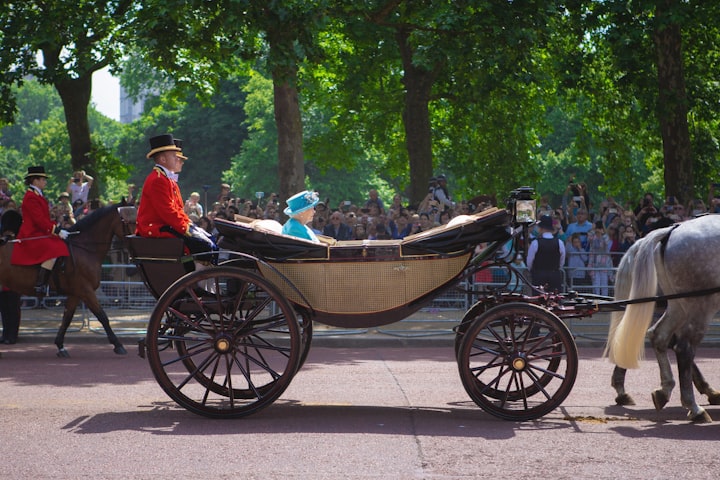Top 10 Craziest Powers About Queen Elizabeth
This article explains the craziest unknown powers of Queen Elizabeth II.

From 6 February 1952 until her passing on 8 September 2022, Elizabeth II (Elizabeth Alexandra Mary; 21 April 1926 - other Commonwealth nations) served as the monarch of the United Kingdom. At the time of her death, she was the queen regnant of 15, down from 32 during her lifetime.
Her 70 years and 214 days of rule made her the longest-reigning female head of state in history as well as the longest reign of any British monarch. Elizabeth was the first child born to the Duke and Duchess of York and was born in Mayfair, London (later King George VI and Queen Elizabeth).
Elizabeth was the presumed heir when her father assumed the throne in 1936 following the abdication of his brother, King Edward VIII. She received a private home education before starting to serve in the Auxiliary Territorial Service during the Second World War.
She wed former Greek and Danish royal Philip Mountbatten in November 1947; their union lasted 73 years until he passed away in April 2021. Edward, Anne, Andrew, and Charles were their four children.
10. The Queen-Owned Swans On The River Thanes:
According to the Royal Family's official website, the Queen technically "exercises her ownership" over all unmarked swans in open water, but only "on specified portions of the Thames and its neighboring tributaries."
This custom is still observed today at the yearly "Swan Upping," when swans in the River Thames are captured, ringed, and released once more as part of a swan population census.
It lasts for five days and is a very formal event. Six skiffs rowed upriver by "swan uppers" wearing traditional garb and in the company of the Queen's Swan Marker.
The Royal Family website states that The Queen's Swan Warden, a professor of ornithology at the University of Oxford's Department of Zoology, "gives the swans a health check and rings them with individual identifying numbers."
9. The Queen Could Drive Without A License:
The Queen is the only person in the United Kingdom who does not legally require a license to drive or a number plate on her cars, according to Time. Although driving permits are given in her name.
The Queen learned to drive while working as a first aid driver for the Women's Auxiliary Territorial Service during World War II, therefore she is proficient behind the wheel despite not being required to hold a license. (According to Time, the Queen's training allows her to also remove a spark plug.)
Additionally, Queen Elizabeth II isn't shy about flaunting her driving prowess. In 1998, she gave a surprise drive-around in her country's residence of Balmoral to the King Abdullah of Saudi Arabia, who was still a prince at the time.
Sherard Cowper-Coles, a former British ambassador, described the encounter in the Sunday Times as follows: "The crown prince and his interpreter sat in the seats behind him in the front Land Rover as directed.
To his surprise, the Queen sat down in the driver's seat, turned the key, and started the car. Abdullah was not accustomed to being driven by a woman, much less a queen, as women are not yet permitted to drive in Saudi Arabia."
Cowper-Coles went on to say: "As the Queen, an army driver during the war, sped up the Land Rover around the winding Scottish estate roads while constantly talking, his anxiety only grew. The crown prince beseeched the Queen to take it easy and focus on the path ahead through his interpreter."
8. The Queen Had Two Birthdays:
One birthday just isn't enough when you're the head of state of the United Kingdom. Although the Queen's actual birthday is on April 21, her official birthday is observed on a Saturday in June.
According to the Royal Mint, official birthday celebrations for sovereigns "have frequently been celebrated on a day other than the actual birthday, particularly when the actual birthday has not been in the summer."
Both birthdays are honored appropriately as well. According to the British Monarchy's official website, gun salutes in central London are fired to commemorate her real birthday. This consists of "a 62-gun salute at the Tower of London, a 62-gun salute in Windsor Great Park, and a 41-gun salute in Hyde Park".
Her Majesty celebrated her 80th birthday in 2006 by going on a walkabout to greet well-wishers in the streets around Windsor Castle. She, however, "is joined by other members of the Royal Family for the spectacular Trooping the Color procession, which moves between Buckingham Palace, The Mall, and Horse guards' Parade" for her "official" birthday celebrations.
7. The Queen Had Her Private Cash Machine:
A special cash machine for use by the royal family is installed in the basement of Buckingham Palace, which is less of a "power" and more of a perk of the job. It is offered by Coutts, one of the elite and prominent banks in Britain.
6. The Queen Had The Power To Form The Government:
Before the passage of the Fixed-Term Parliaments Act in 2011, the Queen could dissolve Parliament and call a general election. A two-thirds majority in the Commons is now needed to dissolve the Parliament before its fixed five-year term expires.
However, she continues to be active after an election when she asks the MP who is most suited to form a government to do so. This raised some concerns before the general election this year.
Once upon a time, it appeared that the Conservatives would attempt to establish a government even though they might not have a majority (despite being the largest party). Even though Labor had fewer seats, it was still possible for them to win a majority by forming a coalition with numerous other parties.
The Queen would have been in a difficult position in this scenario. She gives the Queen's address, which summarizes the government's goals, to begin Parliament each year. Giving David Cameron's speech, however, would be construed as implicitly endorsing his administration, whereas abstaining would convey the reverse.
The Palace later reversed its position after initially telling The Times that she intended to "stay away" if Cameron couldn't secure enough MPs. The Times later claimed that "Royal sources indicated she would lead proceedings, even if there was a chance the speech would be overturned the following week because the Tories had not been able to assemble enough support from smaller parties."
5. The Queen Had Knights:
Even while knights no longer go around on horses courting maidens with tales of bravery, Britain still has knights. They are appointed by the Queen, who also knights them, just like she does with Lords.
Those who have made a significant contribution to British society, whether in business, the arts, the military, or elsewhere, are often awarded knighthoods. When Terry Pratchett received his knighthood, he used meteorite fragments to build a unique sword for himself.
According to the BBC, ministers "who submit her with a list of nominations each year for her approval" choose who gets knighted.
4. The Queen Held The Power To Fire The Australian Government:
The Queen has some influence over the government as Australia's head of state. For instance, Gov. Gen. Sir John Kerr, the country's governor general at the time and the Queen's representative sacked the prime minister in reaction to a government shutdown in 1975.
According to Max Fisher in The Washington Post, "Kerr nominated a substitute who swiftly cleared the spending package to pay the government. "Kerr dismissed the remaining members of Parliament three hours later. Australia then held fresh elections to start over. Since then, there hasn't been another stoppage.
3. The Queen Was The Head Of A Religion:
The Church of England, which was founded after King Henry VIII broke away from the Roman Catholic Church in the 16th century, is led by Queen Elizabeth II.
She is officially known as the Church of England's supreme administrator and defender of the religion, and she has the authority to name Bishops and Archbishops. However, like many of her other powers, she only uses this one when the prime minister, who gets guidance from a Church Commission, recommends it.
This has the odd byproduct of requiring the Sovereign to be a confirmed Church of England, member. The British crown is not open to Catholics or people of other faiths. Suppose Prince Charles converted to Islam, for example, he would be unable to become the king after Queen Elizabeth II dies.
2. The Queen Was Also Immune From Prosecution:
She is immune from prosecution and cannot be forced to testify in court because all prosecutions are conducted in the Sovereign's name.
According to legal expert John Kirkhope, the Sovereign "is incapable of thinking or doing wrong." Baroness Helena Kennedy QC, a lawyer, stated to the BBC in 2002 that "that immunity is doubtful today."
According to the Monarchy's official website, "Although civil and criminal procedures cannot be brought against the Sovereign as a person under UK law, the Queen is careful to ensure that all her acts in her capacity are carried out in strict compliance with the law."
The monarch would almost definitely be forced to abdicate if they were to commit a major offense. At least one instance of the courts bringing charges against the sovereign exists. Following the English Civil War, King Charles I was put on trial for treason in the 17th century.
"No power on earth can rightly bring me (who is your King) in question as a delinquent," he declared. He was executed after the court overruled him.
1. The Queen Had the Right To Warn Ministers:
The Queen's influence over legislation is only meant to extend to the right "to be advised, to encourage, and to warn" her ministers through meetings with the prime minister, assuming there is no "severe constitutional crisis."
CONCLUSION:
Elizabeth was crowned in 1953, and her silver, golden, diamond, and platinum jubilees were commemorated in 1977, 2002, 2012, and 2022, respectively. Only Louis XIV of France held the title of the longest-reigning king in human history, but Elizabeth was the longest-reigning monarch in British history.
Particularly following the dissolution of her children's marriages, her "annus horribilis" in 1992, and the passing of her ex-daughter-in-law Diana, Princess of Wales, in 1997, she occasionally had to deal with republican sentiment and media criticism of her family.
However, both her popularity and support for the monarchy in the United Kingdom remained continuously high. Charles III succeeded Elizabeth after she passed away at Balmoral Castle in Aberdeen shire at the age of 96.





Comments
There are no comments for this story
Be the first to respond and start the conversation.